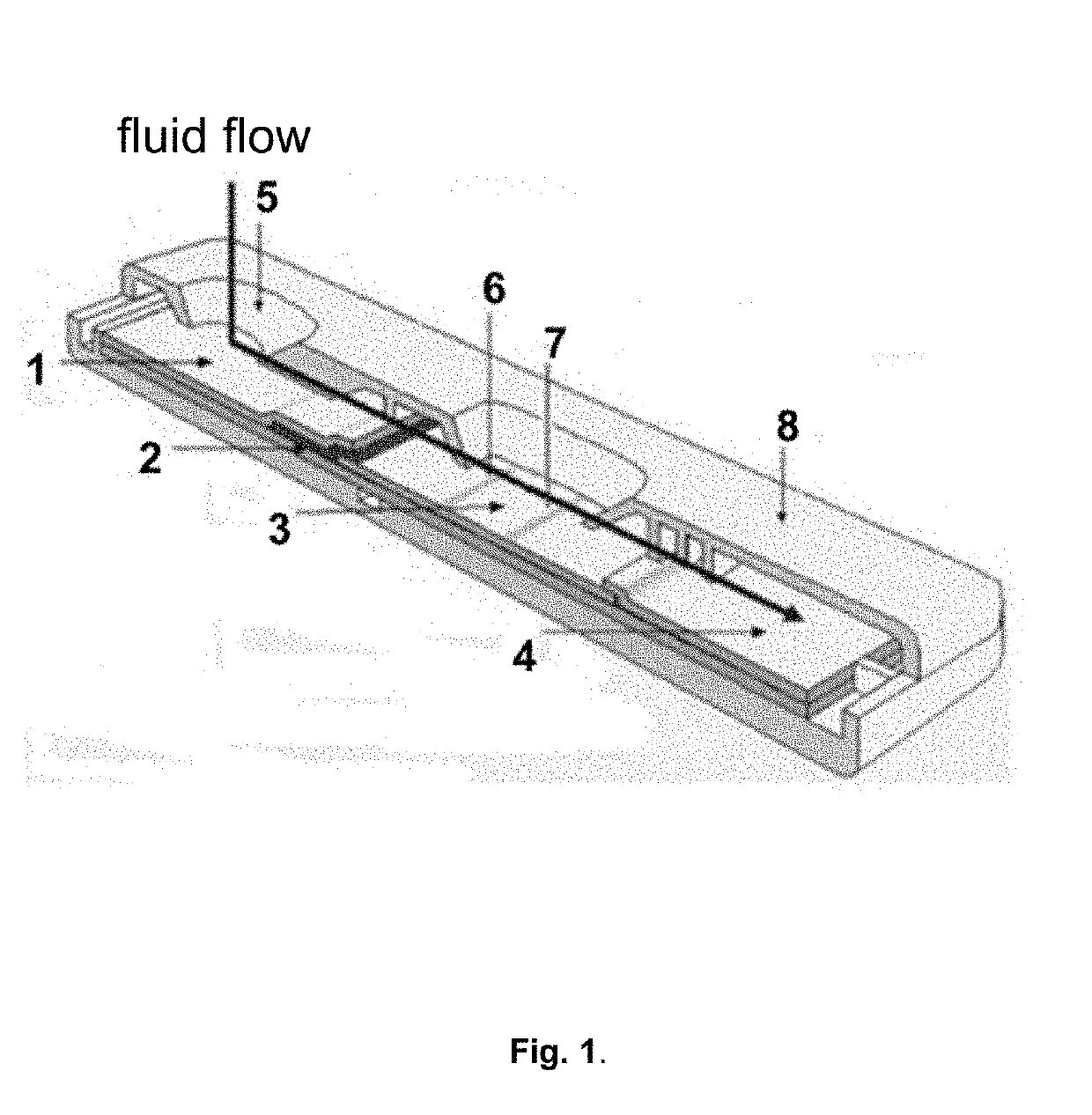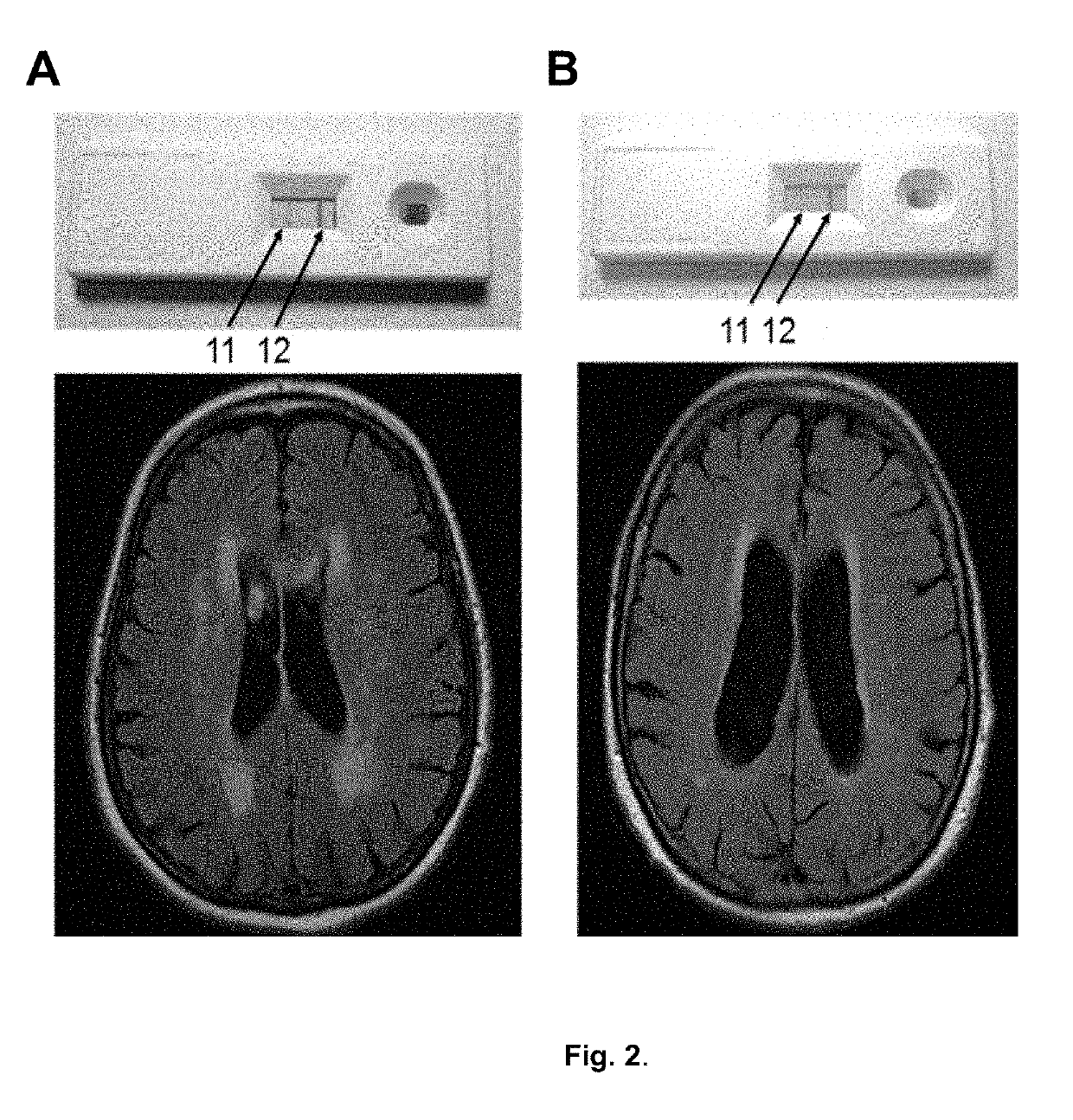Diagnostic reagent kit for detecting chronic brain pathologies of ischemic genesis
a technology of ischemic genesis and diagnostic reagents, which is applied in the field of diagnostic reagent kits for rapid detection of chronic brain conditions of mammals, can solve the problems of a large number of patients, the availability of equipment is much more serious, and the risk of stroke, so as to achieve quick and convenient testing
- Summary
- Abstract
- Description
- Claims
- Application Information
AI Technical Summary
Benefits of technology
Problems solved by technology
Method used
Image
Examples
example 1
[0031]Result of determining antibodies to a hybrid peptide by instant diagnostics in chronic cerebral ischemia (with confirmed cytotoxic edema).
[0032]A woman, 77 years old, admitted to the neurological department No. 1 of the Pavlov First Saint Petersburg State Medical University (PFSPSMU) with complaints after a mild craniocerebral injury. Risk factors in the form of hypertension, type 2 diabetes, and advanced atherosclerosis were identified. Neurological status: 1) Moderate cognitive impairment; 2) Bilateral pyramidal insufficiency; 3) Radicular syndrome of L4-L5 on the right; 4) Polyneuropathic syndrome with shortening of vibration sensitivity and loss of Achilles tendon reflexes.
[0033]A diagnostic rapid test was performed using the test strip of this invention, as well as a brain MRI scan in the T2 FLAIR mode (FIG. 2A). In the MRI images, a cytotoxic edema was detected (manifested as light areas). The diagnostic rapid test showed the presence of two lines (FIG. 2A).
example 2
[0034]Result of determining antibodies to a hybrid peptide by instant diagnostics in chronic cerebral ischemia (with confirmed cytotoxic edema).
[0035]A woman, 83 years old, admitted the neurological department No. 1 of the PFSPSMU with complaints of unsteady gait, stiffness in limb movements, periodic sensations of blackout, dizziness, trembling in the whole body, pedal edema. Previously, she was hospitalized in the PFSPSMU with a diagnosis of dyscirculatory encephalopathy of degree III, a syndrome of vascular Parkinson disease. Risk factors in the form of hypertension, and advanced atherosclerosis were identified. Neurological status: 1) mild cognitive impairment; 2) pseudobulbar syndrome; 3) parkinsonian syndrome; 4) bilateral pyramidal insufficiency; 5) disorder of statics and dynamics in the lumbar spine.
[0036]A diagnostic rapid test was performed using the test strip of this invention, as well as a brain MRI scan in the T2 FLAIR mode (FIG. 2B). In the MRI images, a cytotoxic ed...
example 3
[0037]Pilot study of patients of the Saint Petersburg State Medical University using diagnostic test strips of this invention.
[0038]The study enrolled 10 subjects with an established working diagnosis of dyscirculatory encephalopathy / chronic disorder of cerebral circulation (CDCC), which according to the International Classification of Diseases corresponds to the code 167 (167.2 Cerebral atherosclerosis, 167.4 Hypertensive encephalopathy, 167.8 Other specified lesions of the cerebral vessels). The diagnosis was confirmed by clinical (neurological examination), neuro-psychological (MMSE and FAB scales) and instrumental research methods (neuroimaging, duplex scanning); 3 men and 7 women took part in the study, the mean age was 68.3 years. Magnetic resonance imaging (MRI) in the modes of T1, T2, T2 FLAIR, DWI, GRE, as well as other examination methods aimed at searching potential risk factors for cerebral circulation disorders, were performed to all participants of the study. Thus, ath...
PUM
| Property | Measurement | Unit |
|---|---|---|
| length | aaaaa | aaaaa |
| binding affinity | aaaaa | aaaaa |
| fluorescent | aaaaa | aaaaa |
Abstract
Description
Claims
Application Information
 Login to View More
Login to View More - R&D
- Intellectual Property
- Life Sciences
- Materials
- Tech Scout
- Unparalleled Data Quality
- Higher Quality Content
- 60% Fewer Hallucinations
Browse by: Latest US Patents, China's latest patents, Technical Efficacy Thesaurus, Application Domain, Technology Topic, Popular Technical Reports.
© 2025 PatSnap. All rights reserved.Legal|Privacy policy|Modern Slavery Act Transparency Statement|Sitemap|About US| Contact US: help@patsnap.com


